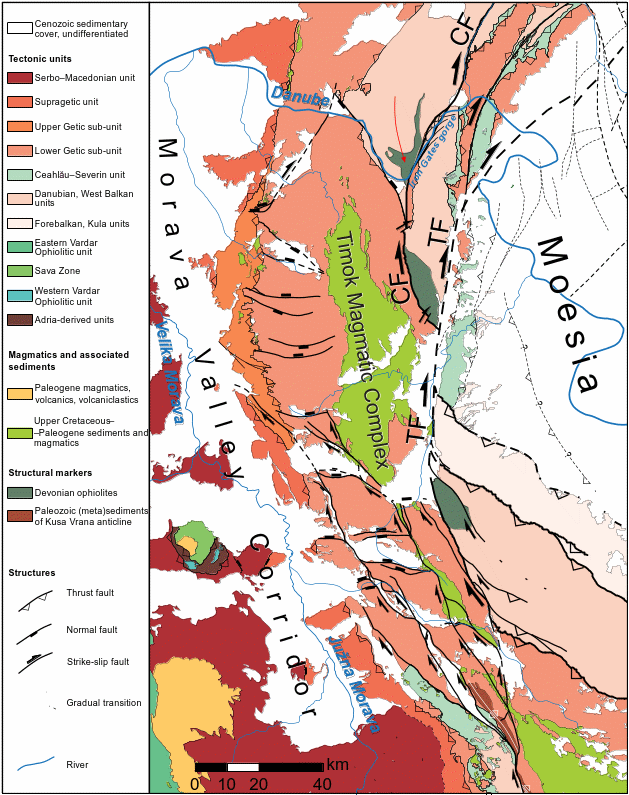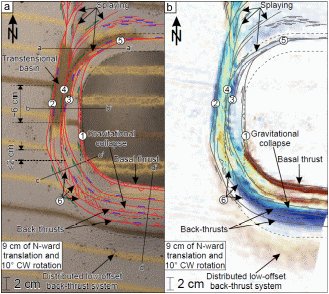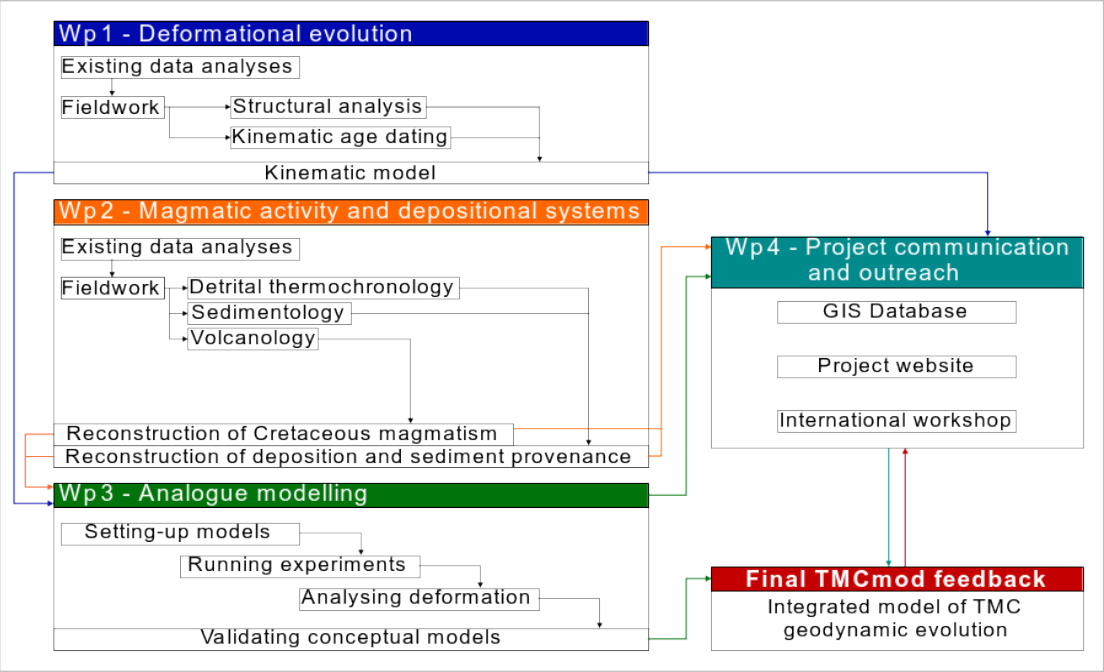

Project summary
Among the many examples observed worldwide, the Timok Magmatic Complex (TMC) basin of the Serbian Carpathians represents an excellent area for a process-oriented study on the interplay between tectonics, sedimentation, and magmatism in continental back-arc basins above evolving subducted slabs. The TMC is a segment of the larger Late Cretaceous Apuseni-Banat-Timok-Srednogorie (ABTS) magmatic belt, formed in response to the subduction of the Mesozoic Neotethys oceanic lithosphere beneath the Carpatho-Balkanides of south-eastern Europe. However, despite many qualitative studies, the quantitative link between the subducted slab's mechanics and the overlying basins' evolution is less understood. Within the scope of the newly funded TMCmod project, supported by the Science Fund of the Republic of Serbia (GRANT No TF C1389-YF/PROJECT No 7461), coupled field and laboratory kinematic and petrological investigations will be focused on creating a conceptual definition of the TMC geodynamic evolution, by combining near-surface observations with the known evolution of the subduction system. This definition will be subsequently validated through analogue modelling and integrated into a coherent geodynamic model of tectonic switching in basins driven by the evolution of subducted slabs. The new geodynamic model coupling the TMC basin with its Neotethys subduction driver will quantitatively advance the strategy of prospecting and exploration of world-class porphyry copper-gold deposits, which have been actively exploited in this region for more than a century. Furthermore, reconstructed regional kinematic evolution will improve seismic hazard assessment during industrial and societal infrastructure planning and construction.
Concept and objectives
The Timok Magmatic Complex (TMC) in Serbia represents one of the successive segments of the Late Cretaceous Apuseni–Banat–Timok–Srednogorie (ABTS) magmatic belt, where a system of intrusive and extrusive magmatic products was interlayered with sediments in a complex volcano-sedimentary basin (Fig. 1). Due to its location overlying the subducted Neotethys slab, the evolution of the basin was controlled by the changing slab kinematics. This includes its changes from flat advancing to steep retreating during subduction and collision, controlling the tectonic inversion moments and localization of deformation and magmatism in the fore-arc and back-arc system (Fig. 2). The aforementioned observations define the volcano-sedimentary basin hosting the TMC as an excellent natural laboratory for a process-oriented study on the interplay between tectonics, sedimentation, and magmatism in basins above evolving subducted slabs. This multi-disciplinary geoscientific study will be realized within the framework of the research project: GEODYNAMICS OF BASINS ABOVE SUBDUCTED SLABS: an integrated modelling study of tectonics, sedimentation, and magmatism in the Timok Magmatic Complex – TMCmod. The main objective of the TMCmod project is to increase understanding of the interplay between tectonics, sedimentation, and magmatism in continental back-arc basins located above subducting systems with variable kinematics and to develop a first quantitative model coupling the Timok Magmatic Complex (TMC) basin with its Neotethys subduction driver.

Fig. 1 a) Topographic map of Mediterranean Mesozoic–Cenozoic orogens, displaying suture zones, orogenic fronts, and retro-wedges. The red polygon marks the position of Fig. 1b; b) Satellite image of Serbian Carpathians. The red polygon represents the Timok Magmatic Complex (TMC).

Fig. 2 Conceptual sketch of the Cretaceous Neotethys fore-arc to back-arc subduction system.
Methodological approach
The TMCmod project will be realized through a process-oriented multi-disciplinary geoscientific study, focused on the structural control of TMC basin evolution and its associated magmatic and sedimentary processes. Coupled field and laboratory kinematic analyses will be performed to constrain the kinematics and age of activity along major fault zones (Figure 3), which controlled the opening and subsequent inversion of the TMC sedimentary basin and, therefore, affected its sediment deposition, magmatism, and associated ore-formation processes. Furthermore, kinematic investigations will be combined with detailed sedimentological analyses and the new high-resolution petrological, geochronological and thermochronological dating of key magmatic and sedimentary rock sequences. The observational and analytical inferences will be validated by physical analogue modelling, which represents a powerful experimental tool to investigate the interplay between processes in geodynamic settings characterized by variable tectonic regimes, strain rates, magmatic input, and sedimentation rates. The analogue modelling will test the effects of strain rate, magmatic intrusion, and sedimentation rate on the overall evolution of an extensional/transtensional basin. The state-of-the-art equipment (i.e., high-resolution digital cameras, CT scanner, etc.) will be used to monitor the model evolution, while the deformation of the models will be analysed using particle image velocimetry techniques. Integrated data on the kinematics of deformational structures; time, volumes, and depths of magmatic rocks emplacement; as well as the rates of basin deposition will be used as input data during analogue modelling (Figure 4).

Fig. 3 Tectonic map of the Timok Magmatic Complex basin and the surrounding Carpatho-Balkanides orogen.

Fig. 4 a), b) Analogue modelling of complex fault systems.
Expected outcome
The novelty of the TMCmod project lies in its multi-disciplinary approach that, for the first time in Serbia, combines modern field and laboratory analyses of tectonic structures, absolute ages of rocks and deformation, basin infill provenance analysis, reconstruction of depositional systems, and analogue modelling of the segment of the upper plate back-arc system where the TMC is developed (Figure 5). The results of the kinematic study will enable a better understanding of the mechanisms and timing of TMC back-arc basin opening and its subsequent moments of inversion. The obtained petrological results will provide new constraints on the age, volumes, and depths of shallow sub-volcanic intrusions emplacement in the TMC basin and define genetic links of magmatism and associated ore-formation processes. In addition, we will determine the provenance and deposition rates of Cretaceous sedimentation in the TMC basin and reconstruct its depositional systems. The new analogue geodynamic model of the TMC basin and its correlation with other segments of the ABTS belt improve the overall understanding of the interplay between tectonics, magmatism, and sedimentation in the back-arc settings. The new inferences can be used in various geodynamic realms where similar controlling mechanisms on basin(s) evolution can be recognized. The well-documented geodynamic model of the TMC basin will be very useful for planning and realization of all future geological studies and mining of mineral resources in this area, since the TMC represents an important mining province, where world-class porphyry copper-gold deposits are actively exploited for more than a century. The TMC represents a region with a moderate level of recent seismic activity. Constraints on kinematics and time of activity of major regional faults will facilitate the detection of their seismo-tectonically active segments. That, again, will improve natural hazard assessment during the planning and construction of industrial and private objects.

Fig. 5 TMCmod project implementation scheme.